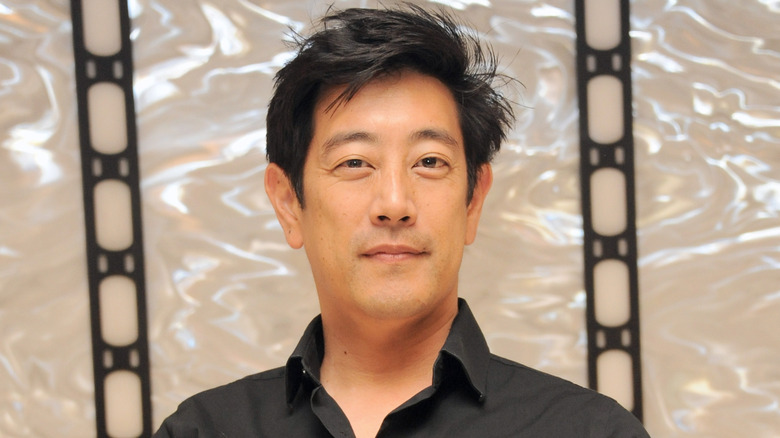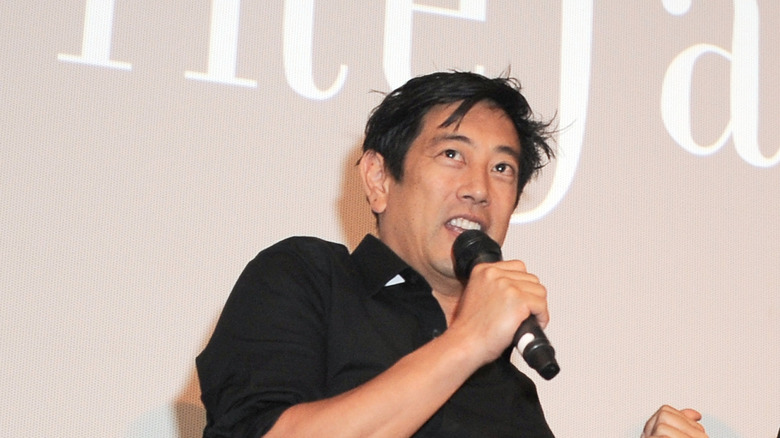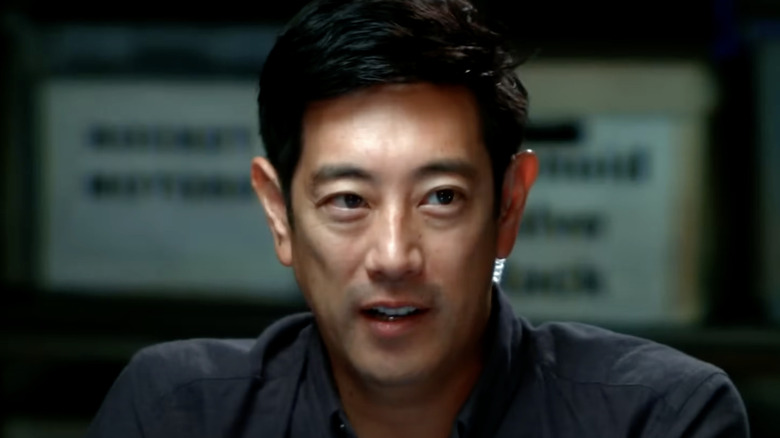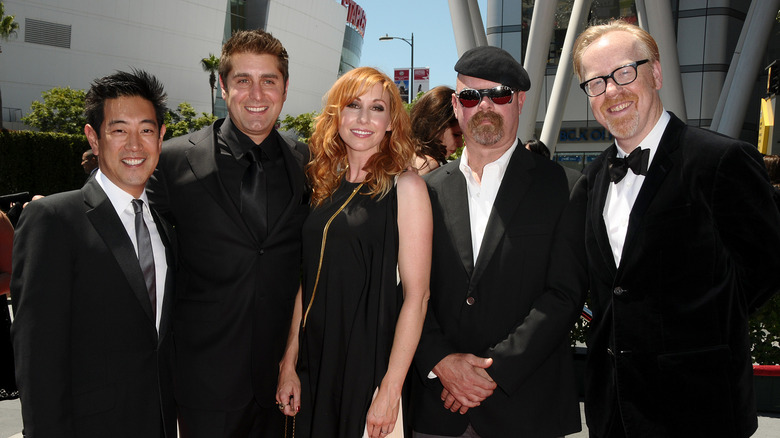Grant Imahara's Most Dangerous Moments On MythBusters
Grant Imahara joined the already in progress and already popular Discovery Channel series "MythBusters" for its third season. He'd remain on the educational but wildly entertaining reality show for 11 years until 2014, conducting dangerous experiments and showing off inherent truths about science with his background and bona fides fueling him. Before (and after) he was a TV tester, Imahara invented a number of technologies and worked in engineering, animatronics, robotics, and special effects.
The effects of an aneurysm caused Imahara's death in July 2020 at the age of 49. One of the most tragic things to happen to the "MythBusters" cast, Imahara's former costars said a lot of nice things as they mourned and celebrated the scientist. His early death was so unexpected, especially since ironically, Imahara avoided major injury to himself and to his cohort fairly regularly during the production of their long-running show. Here are all the times Grant Imahara flirted with danger and disaster on "MythBusters."
Grant Imahara made a coffee creamer fireball
On the 2008 "MythBusters" episode called "Viral Hour," both teams of testers explored scientific principles that spread around the internet via popular videos and memes. Grant Imahara, along with Tory Belleci and Kari Byron, looked into the notion that sawdust, when fire was applied, would ignite to form a large fireball. That theory was confirmed, and so the trio investigated another supposed truth: that powdered nondairy creamer was flammable because of the combination of chemicals required to make the shelf-stable, milk-free coffee condiment.
The team stuffed 500 pounds' worth of powdered creamer into an air cannon rigged with flares. Imahara rigged the equipment, and Belleci applied the flame. It took a few seconds to get going. "All of a sudden the flare lights it, and it turns into this growling monster of sugary coffee creamer on fire in the sky," Byron told Mental Floss of the gigantic mass that began as a white and smoky entity that quickly turned into a sky-filling ball of fire. Imahara and company figured they waited at a safe distance away from the site of the explosion, not expecting it to be as serious as it was. "And then the wind changed, and it started coming at us," Byron said. "MythBusters" cameras caught Imahara dodging the intensely hot flames when they got within a few feet.
He got hit by a flying hammer
"Firearms Folklore," a 2006 episode of "MythBusters," found its crews of curious scientists digging into the science of weaponry, such as bullets, guns, and a little curiously, hammers. Grant Imahara and Tory Belleci were interested in the relatively obscure ballistics-related myth, which states that if two similar hammers both made of metal strike each other with enough force, they'll break off and throw up dangerous little shards of sparking or explosive material.
Belleci devised a robotic device, which had opposing mechanical arms outfitted with hammers to smash into one another. Imahara didn't think the machine would be able to work fast enough to get viable data, or at least not as quickly as a human might be able to swing the tool. While trying out his hammer strength by trying to hit a nail in a board, Belleci missed entirely. The hammer flew several feet behind Belleci, where Imahara thought was a safe observation point. Instead, the tool soared with such force that it struck him painfully in the lower leg.
Grant Imahara encountered toxic human waste
The most common potential workplace hazards on the set of "MythBusters" were speed, fire, and heavy-duty machinery. But the show, in its intrepid pursuit of truth, could also get disgusting, to the point where Grant Imahara once had to get very close to biological waste. One of the legends looked at in the 2009 episode "Mini Myth Mayhem" was if it's possible to build a working candle out of earwax, a concept that got the show's attention when it was executed in a "Shrek" movie.
A doctor specializing in ear, nose, and throat concerns procured for the "MythBusters" production earwax in bulk, purportedly removed from the canals of hundreds of the physician's own patients. Imahara began the experiment by heating up the specimen jar full of earwax chunks so as to melt it down into a pliable state. "And that's when things went horribly wrong," Imahara told Mental Floss. "We found out later on that the reason that the doctor had removed all the earwax from people's ears was because it was infected." The smell of burning, germ-laden earwax was so noxious that it caused Imahara to spontaneously dry vomit. He couldn't continue to participate in the experiment, such was the severity of the smell. Other crew members made the candle, which didn't light. "It was probably the grossest thing I've ever done in my life," Imahara revealed.
Grant Imahara helped shoot a cannonball through a house
While producing an episode of "MythBusters" in December 2011, several members of the on-screen teams conducted some experiments on cannonballs. Many safety measures were in place: The testing took place at the Alameda County Sheriff's Department bomb range in Northern California, and was watched over by a trusted bomb tech. After many shots went according to plan, one launched cannonball went errant, to say the least, bouncing off of a safety barrier and moving past the range and into a neighborhood about 700 yards away. Its flight came to an end when it ran through a home and then into a parked vehicle.
Before the ill-fated experiment, "MythBusters" cast member Grant Imahara had posted a message (which was later deleted) on X, then known as Twitter, about how the show would be working with artillery that day, but there wasn't any other kind of warning. Grant Imahara, along with co-stars Kari Byron, Tory Belleci, Adam Savage, and Jamie Hyneman, categorized that cannonball incident as their single worst experience in "MythBusters" history.
He nearly ripped his stomach apart
"Flying Guillotine," a 2011 episode of "MythBusters," looked to see if a weapon seen in some old martial arts movies set in the 18th century really could have existed and worked as shown. Nicknamed the "flying guillotine" by Grant Imahara's Build Team, the device created would have to be capable of both beheading an enemy combatant and then returning the decapitated head to the user.
It took some trial and error for Imahara's prototype to work, although he found it easier to use in a speculated planned assassination than in a brisk combat or attack situation. Imahara used dummies in the tests, but he nearly laid waste to a real human with the potentially deadly device. "I accidentally triggered it when I was like three quarters loaded. And it sort of cut my shirt," Imahara admitted in a "MythBusters" aftershow. After almost cutting open his own stomach with a speculative re-creation of a head-chopping device, Imahara took to wearing a protective leather apron from that point.





